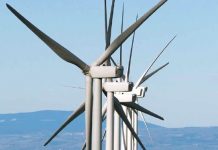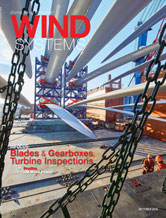When conjuring up an image of a wind turbine, what’s the first thing that comes to mind?
Is it the tower that juts up hundreds of feet off the ground and into the sky? No. More than likely, the first thought is of those three massive blades, spinning with the wind like some gargantuan piece of modern art.
It can be so mesmerizing, that the realization the rotating blades are actually producing clean, renewable energy might come as an afterthought.
But those blades are critical, whether it’s their design and construction or methods to keep them functioning properly throughout their decades-long lifespan.
Blades and the gearboxes from which they sprout are precision components with often delicate dispositions.
That’s why companies invest a lot of time and resources making sure the turbines get the utmost care from start to finish.
In the October issue of Wind Systems, we focus on blades and gearboxes and the inspection process that keeps turbines in optimum running condition.
We start with our company profile. LM Wind Power, headquartered in Denmark, has been manufacturing turbine blades since 1978. The company is proud of its “big” reputation. How big? It recently created the world’s longest turbine blade at more than 88 meters. Want some perspective? If you were standing on the goal line of a football stadium, you’d only be 4 yards short of the opposite goal line. Mind blown? Mine was.
But a lot can happen to a blade after it starts its lifetime of spinning. And that’s why companies exist to make sure those blades keep on doing what they were designed to do.
Our inFocus for October also features an article explaining new weather technology that aids in assessing lightning damage to wind turbines.
New processes designed to help protect blades from problems such as leading-edge erosion are discussed in an article from 3M Wind Energy.
In the realm of gearboxes, Castrol presents an article that argues transient events, not gearbox oil, is the cause of gearbox failure.
Keeping turbines maintained can often involve a series of complex checks and balances. SKF shares an article about a new monitoring system that would police turbines and flag potential problems before they grow into costly, time-consuming headaches.
That’s just a taste of what this month’s inFocus section has to offer in addition to our other regular sections highlighting wind power’s latest strides and accomplishments.
October’s Wind Systems is full of interesting wind information. I hope you enjoy reading it as much as I enjoyed presenting it to you.
































